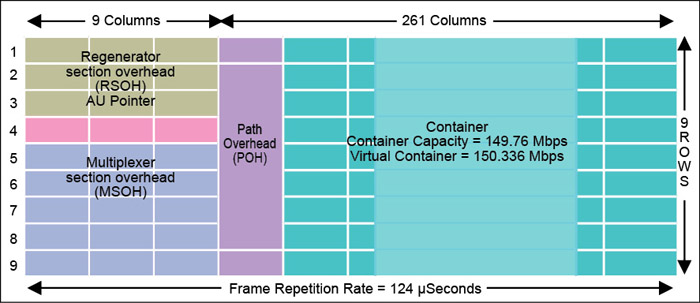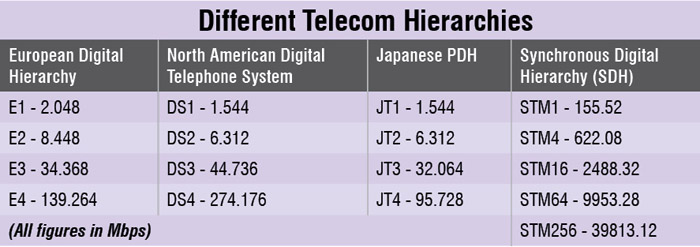The phrase ‘necessity is the mother of all invention’ equally applies when we talk about telecom signal transmission. Limitations of older transmission technologies, enhanced quality of service requirements, need for tightly synchronised networks and many more similar requirements are the drawing forces for the evolution of a new kind of digital transport system—the SDH (synchronous digital hierarchy).
Basically, SDH is a new kind of synchronous digital hierarchy—standardised by ITU-T (International Telecommunication Union for the telecommunication standardisation sector)—for a high-capacity telecom transmission network for transporting large amounts of voice and data traffic over a common transmission media. As the name suggests, synchronous implies the use of a master clock with which all network elements are tightly synchronised; digital implies the information in binary form and hierarchy implies a set of bit rates in a hierarchical order.
SDH frame structure
SDH was essentially developed to replace legacy PDH (plesiochronous digital hierarchy) systems. Its frame structure is designed in such a way that it can encapsulate earlier digital transmission standards, such as the E1, PDH or ATM (asynchronous transfer mode) networking, making SDH an all-purpose transport system. The basic unit of framing in SDH is STM-1 (synchronous transport module-level one), which consists of a matrix of nine rows and 270 columns (Fig. 1). Each cell carries one byte. Transmission is carried out row by row, starting with the byte in the upper-left corner and ending with the byte in the lower-right corner. After transmission of the last byte in the frame (the byte located in row 9, column 270) is complete, the whole sequence repeats. The frame repetition rate is 125 microseconds; therefore there are 8000 frames per second. Each byte in the payload represents a 64-kbit/s channel. So, the total number of bits that can be transported by STM-1 frames is 9×270×8×8000. Thus, the basic STM-1 frame bit rate equals to 155.52Mbits/s. SDH is a transport hierarchy based on multiples of 155.52Mbps in which each rate is an exact multiple of the lower rate; therefore the hierarchy is synchronous. Different SDH rates are STM-1 = 155.52Mbps, STM-4 = 622.08Mbps, STM-16 = 2588.32Mbps, STM-64 = 9953.28Mbps and STM-256 = 39813.12Mbps.

As indicated in Fig. 1, SDH frame is made up of a container and a section overhead—section overhead being further divided into regenerator section overhead (RSOH), administrative unit pointer (AU) and multiplexer section overhead (MSOH).
The container carries customer traffic (voice, data, video, etc) and can accommodate different kinds of signal data like Ethernet, PDH signals and ATM signals. The container, together with path overhead (POH), makes a virtual container (VC). POH is used for end-to-end signaling and error measurement.

The section overhead provides facilities that are required to support and maintain the transportation of customer traffic safely across the network. RSOH occupies 27 octets, containing information about the frame structure required by the terminal equipment. MSOH occupies 45 octets, containing information about error correction and automatic protection switching (APS) messages (such as alarms and maintenance messages) as may be required within the network. AU pointer points to the location of the J1 byte in the payload—the first byte in the virtual container.




